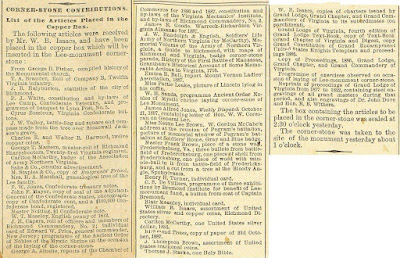 |
| Israel Antiquities Authority |
|
And now, I have sent a wise man, endowed with understanding, of my father Huram. The son of a woman of the daughters of Dan, and his father was a Tyrian man, who knew how to work with gold, with silver, with copper, with iron, with stones, with wood, with purple, with blue, and with fine linen and with crimson yarn …
II Chronicles 2:12-13
Adapted for use in the Master Mason Degree Lecture in many lodges
Here’s something you don’t see every day: The Israel Antiquities Authority announced Thursday the discovery of a tiny piece of ancient fabric exhibiting “scarlet worm.”
I don’t see anything on the IAA’s website explaining this, but The Times of Israel, among others, reports on the find. The following is copyright ©️ 2024 The Times of Israel.
Tiny 3,800-year old textile
found in Israel was dyed
with biblical ‘scarlet worm’
Israeli researchers have confirmed that a 3,800-year-old scarlet-red textile found in the Judean Desert in 2016 was dyed using a tiny insect referred to throughout ancient sources, according to an article published this week in the Journal of Archaeological Science.
The peer-reviewed study was a joint effort of Hebrew University, Bar-Ilan University and the Israel Antiquities Authority, researchers said in a press release. Archaeologists discovered the piece of textile, less than 2 centimeters (about a half-inch) across, in the so-called “Cave of Skulls” in the Tze’elim Stream near Masada, during a joint excavation to save heritage finds from antiquities theft in 2016.
 |
IAA The Cave of Skulls. |
Researchers were struck by the textile’s dark-red color. Scientists carbon-dated the artifact to the Middle Bronze Age (20th-18th centuries BCE), and employed high-performance liquid chromatography—a technique used to identify the ingredients of mixed solutions—to trace the origin of the dye to a scale insect called Kermes vermilio. The crimson bug, found throughout the Mediterranean region but not in Israel itself, is probably the same “scarlet worm” (tola’at hashani) mentioned 25 times in the Bible, often next to mentions of blue (techelet) and purple (argaman), considered the most precious and prestigious colors in the ancient world.
 |
IAA The Scarlet Worm. |
In the Bible, the Israelites are commanded to use the “scarlet worm” to dye the fabrics of the Tabernacle and the priestly garments. “In ancient times, the dye was produced from the female scale insect, which lives on the kermes oak tree (Quercus coccifera),” Na’ama Sukenik of the Israel Antiquities Authority explained in a press release.
“Collecting these kermes was done in a very short window of time—one month of the year, in the summer, after the female had laid her eggs but before they hatched—when the amount of dye was greatest,” Sukenik said.
Though references to dyes made from scale insects abound in ancient sources, very few textiles dyed with the creatures have been found that predate the Roman period. The tiny textile is the earliest evidence of the technique ever discovered, and “bridges the gap between written sources and the archaeological discoveries,” Sukenik said.
Lucky timing for this news. I was just preparing a Magpie post on the subject of the Auld Boy YouTube channel, where there is frequent and recent discussion of ancient purple, whether from Tyre or elsewhere. Click here.














































































